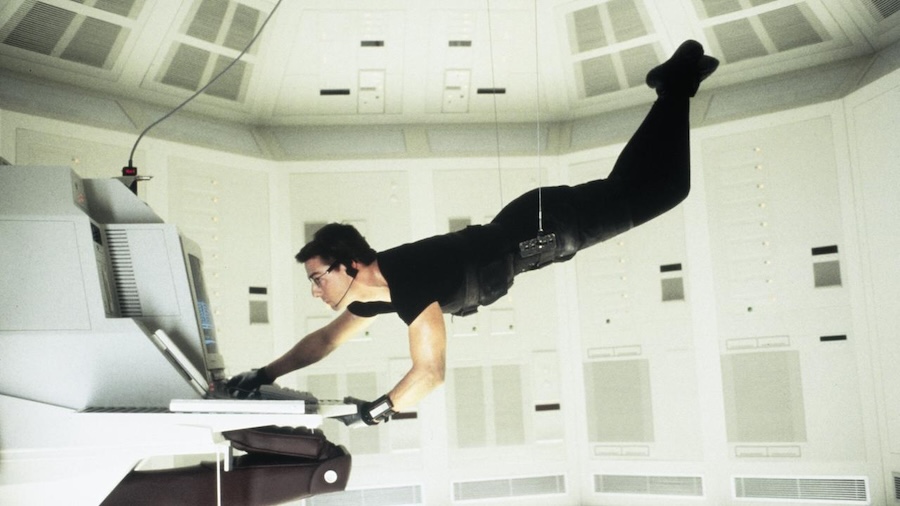
EXPECT THE IMPOSSIBLE.

Eleven years ago, I stepped out of a theater together with my buddies after watching Mission: Impossible and was as enthusiastic as any twenty-year-old can be about a movie. Perhaps I made too big a deal out of it, but when I watched the DVD a few nights ago I realized that I wasn’t far off. This film is grossly underappreciated.
When Tom Cruise and producer Paula Wagner set up shop at Warner, they learned that the studio owned the rights to the classic 1960s TV show Mission: Impossible and got excited about making a movie based on it. Hiring Brian De Palma to direct was a safe choice; after all, he was the guy who made the astonishing film version of another TV show, The Untouchables. Two talented screenwriters (including veteran Robert Towne) came up with a script that some found overly convoluted. It also aroused the ire of die-hard fans of the show because it made a villain out of a classic character.
The sole survivor
The story begins in Prague where members of the IMF, a special intelligence task force, are set to expose a traitor who intends to steal the NOC list, which contains information on IMF’s all agents and their secret identities. But the mission goes awry and every member of the team except for Ethan Hunt (Tom Cruise) is murdered. Ethan realizes that his superiors think he is the traitor, leading him to go on the lam. It turns out that another member of the team, Jim Phelp’s (Jon Voight) wife Claire (Emmanuelle Béart), survived and together they find that the mole, who in online conversations referred to himself as Job, was in touch with someone called “Max” who wanted to buy the stolen NOC list…
A Hitchcockian hero
There were fans complaining that the film’s focus on one agent rather than a whole team was not an idea true to the TV series, but Cruise holds it together as a sort of Hitchcockian hero, figuring out how he was framed. De Palma builds several sequences in the fashion that has made him famous; complex and stylish, they require complete attention from the audience; things may not be what they seem. There’s a quiet sequence I love where a key character reappears and starts telling Ethan what happened that night in Prague. He doesn’t know that Ethan has already understood that he is the mole. As Ethan pretends to listen to him, De Palma shows us the agent figuring out in his mind how the mole must have orchestrated the murders of the other team members. A perfect example of how to use film as a medium.
That’s brilliance on the part of the special effects crew.
Then there’s the two masterful, much showier set pieces that really had people talking. The elaborate yet discreet Langley heist is classic De Palma (love that falling knife) and the concluding fight and chase involving a helicopter and a TGV train is sheer brilliance. It looks like it could be done even though we know it couldn’t. That’s brilliance on the part of the special effects crew.
U2 members Adam Clayton and Larry Mullen wrote a special version of Lalo Schifrin’s theme for the TV show, which is played during the end credits. An explosive piece of music, it ends the film on a high note and sends audiences out longing to accept another mission.
Mission: Impossible 1996-U.S. 110 min. Color. Widescreen. Directed by Brian De Palma. Screenplay: David Koepp, Robert Towne. Cinematography: Stephen H. Burum. Music: Danny Elfman. Makeup: Rob Bottin, and others. Cast: Tom Cruise (Ethan Hunt), Jon Voight (Jim Phelps), Emmanuelle Béart (Claire Phelps), Henry Czerny, Jean Reno, Ving Rhames, Kristin Scott Thomas, Vanessa Redgrave. Cameo: Emilio Estevez.
Trivia: Co-produced by Cruise. The TV series ran from 1966-1973 and 1988-1990. Peter Graves, who played Phelps on the show, declined an offer to reprise the role. Followed by seven sequels, starting with Mission: Impossible II (2000).
Last word: “It becomes personal because I’d created the initial storyline with Steve Zaillian. There were many screenplays before, and I took it in a direction that appealed to me. So it’s very much a story that I wanted to tell. You weren’t just handed a script and told, ‘figure out how to direct this.’ We created the whole Mission: Impossible scenario. It took us many months. So it’s very different than, you know, directing something that’s been pretty much worked out and the script that you accept to do.” (De Palma, De Palma a la Mod)
